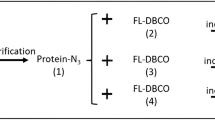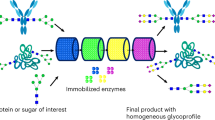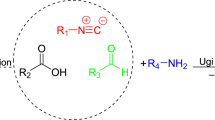Abstract
Transpeptidation catalyzed by sortase A allows the preparation of proteins that are site-specifically and homogeneously modified with a wide variety of functional groups, such as fluorophores, PEG moieties, lipids, glycans, bio-orthogonal reactive groups and affinity handles. This protocol describes immobilization of sortase A on a solid support (Sepharose beads). Immobilization of sortase A simplifies downstream purification of a protein of interest after labeling of its N or C terminus. Smaller batch and larger-scale continuous-flow reactions require only a limited amount of enzyme. The immobilized enzyme can be reused for multiple cycles of protein modification reactions. The described protocol also works with a Ca2+-independent variant of sortase A with increased catalytic activity. This heptamutant variant of sortase A (7M) was generated by combining previously published mutations, and this immobilized enzyme can be used for the modification of calcium-senstive substrates or in instances in which low temperatures are needed. Preparation of immobilized sortase A takes 1–2 d. Batch reactions take 3–12 h and flow reactions proceed at 0.5 ml h−1, depending on the geometry of the reactor used.
This is a preview of subscription content, access via your institution
Access options
Subscribe to this journal
Receive 12 print issues and online access
$259.00 per year
only $21.58 per issue
Buy this article
- Purchase on Springer Link
- Instant access to full article PDF
Prices may be subject to local taxes which are calculated during checkout






Similar content being viewed by others
References
Milla, P., Dosio, F. & Cattel, L. PEGylation of proteins and liposomes: a powerful and flexible strategy to improve the drug delivery. Curr. Drug Metab. 13, 105–119 (2011).
Veronese, F.M. Peptide and protein PEGylation: a review of problems and solutions. Biomaterials 22, 405–417 (2001).
Pillow, T.H. et al. Site-specific trastuzumab maytansinoid antibody-drug conjugates with improved therapeutic activity through linker and antibody engineering. J. Med. Chem. 57, 7890–7899 (2014).
Popp, M.W., Antos, J.M., Grotenbreg, G.M., Spooner, E. & Ploegh, H.L. Sortagging: a versatile method for protein labeling. Nat. Chem. Biol. 3, 707–708 (2007).
Witte, M.D. et al. Preparation of unnatural N-to-N and C-to-C protein fusions. Proc. Natl. Acad. Sci. USA 109, 11993–11998 (2012).
Pritz, S. et al. Synthesis of biologically active peptide nucleic acid-peptide conjugates by sortase-mediated ligation. J. Org. Chem. 72, 3909–3912 (2007).
Samantaray, S., Marathe, U., Dasgupta, S., Nandicoori, V.K. & Roy, R.P. Peptide-sugar ligation catalyzed by transpeptidase sortase: a facile approach to neoglycoconjugate synthesis. J. Am. Chem. Soc. 130, 2132–2133 (2008).
Antos, J.M., Miller, G.M., Grotenbreg, G.M. & Ploegh, H.L. Lipid modification of proteins through sortase-catalyzed transpeptidation. J. Am. Chem. Soc. 130, 16338–16343 (2008).
Popp, M.W., Dougan, S.K., Chuang, T.Y., Spooner, E. & Ploegh, H.L. Sortase-catalyzed transformations that improve the properties of cytokines. Proc. Natl. Acad. Sci. USA 108, 3169–3174 (2011).
Chen, I., Dorr, B.M. & Liu, D.R. A general strategy for the evolution of bond-forming enzymes using yeast display. Proc. Natl. Acad. Sci. USA 108, 11399–11404 (2011).
Antos, J.M. et al. Site-specific N- and C-terminal labeling of a single polypeptide using sortases of different specificity. J. Am. Chem. Soc. 131, 10800–10801 (2009).
Williamson, D.J., Fascione, M.A., Webb, M.E. & Turnbull, W.B. Efficient N-terminal labeling of proteins by use of sortase. Angew Chem. Int. Ed. Engl. 51, 9377–9380 (2012).
Hess, G.T. et al. M13 bacteriophage display framework that allows sortase-mediated modification of surface-accessible phage proteins. Bioconjug. Chem. 23, 1478–1487 (2012).
Mao, H., Hart, S.A., Schink, A. & Pollok, B.A. Sortase-mediated protein ligation: a new method for protein engineering. J. Am. Chem. Soc. 126, 2670–2671 (2004).
Guimaraes, C.P. et al. Identification of host cell factors required for intoxication through use of modified cholera toxin. J. Cell Biol. 195, 751–764 (2011).
Popp, M.W., Artavanis-Tsakonas, K. & Ploegh, H.L. Substrate filtering by the active site crossover loop in UCHL3 revealed by sortagging and gain-of-function mutations. J. Biol. Chem. 284, 3593–3602 (2009).
Popp, M.W., Antos, J.M. & Ploegh, H.L. Site-specific protein labeling via sortase-mediated transpeptidation. Curr. Protoc. Protein Sci. 56, 15.3.1–15.3.9 (2009).
Hirakawa, H., Ishikawa, S. & Nagamune, T. Design of Ca2+-independent Staphylococcus aureus sortase A mutants. Biotechnol. Bioeng. 109, 2955–2961 (2012).
Wuethrich, I. et al. Site-specific chemoenzymatic labeling of aerolysin enables the identification of new aerolysin receptors. PLoS ONE 9, e109883 (2014).
Guimaraes, C.P. et al. Site-specific C-terminal and internal loop labeling of proteins using sortase-mediated reactions. Nat. Protoc. 8, 1787–1799 (2013).
Theile, C.S. et al. Site-specific N-terminal labeling of proteins using sortase-mediated reactions. Nat. Protoc. 8, 1800–1807 (2013).
Steinhagen, M., Zunker, K., Nordsieck, K. & Beck-Sickinger, A.G. Large scale modification of biomolecules using immobilized sortase A from Staphylococcus aureus. Bioorg. Med. Chem. 21, 3504–3510 (2013).
Acknowledgements
This work was supported by funding from The Netherlands Organisation for Scientific Research (to M.D.W.) and the US National Institutes of Health (NIH; grant no. RO1 AI087879 to H.L.P.).
Author information
Authors and Affiliations
Contributions
M.D.W., C.P.G. and H.L.P. conceived of the idea; M.D.W., T.W., C.S.T., C.P.G. and A.E.M.B. performed the immobilization reactions and optimized the sortase reactions in batch and in flow; J.R.I. developed the heptamutant sortase; and Z.L. and L.K. assisted in sortase and protein production; M.D.W., T.W., C.S.T., C.P.G., J.R.I. and H.L.P. wrote the manuscript; and S.D.G. and H.L.P. supervised the project.
Corresponding author
Ethics declarations
Competing interests
The authors declare no competing financial interests.
Rights and permissions
About this article
Cite this article
Witte, M., Wu, T., Guimaraes, C. et al. Site-specific protein modification using immobilized sortase in batch and continuous-flow systems. Nat Protoc 10, 508–516 (2015). https://doi.org/10.1038/nprot.2015.026
Published:
Issue Date:
DOI: https://doi.org/10.1038/nprot.2015.026
This article is cited by
-
One-step purification and immobilization of extracellularly expressed sortase A by magnetic particles to develop a robust and recyclable biocatalyst
Scientific Reports (2017)
-
A Modular Vaccine Development Platform Based on Sortase-Mediated Site-Specific Tagging of Antigens onto Virus-Like Particles
Scientific Reports (2016)
Comments
By submitting a comment you agree to abide by our Terms and Community Guidelines. If you find something abusive or that does not comply with our terms or guidelines please flag it as inappropriate.



